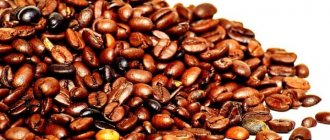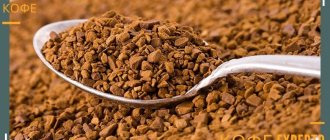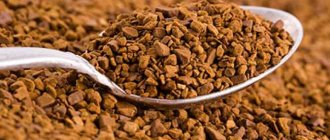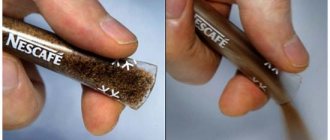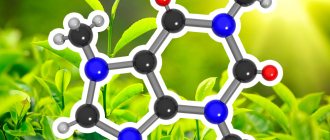We hope you don't drink instant. And that's why.
Just four letters connect millions of people around the world. The army of coffee lovers is growing every day.
The taste of coffee is wonderful, but incomprehensible. You need to learn to understand and love it, and only then enjoy it.
— Gustave Flaubert
Many of us love coffee, but didn’t come to it right away. Personally, at first I didn’t understand why drink coffee? What does it give? It doesn't charge me! Is there something wrong?
I delved deeper into the topic and everything fell into place.
What's in coffee
The structure of the coffee bean is simple. Like any cereal crop, there is an outer and inner shell. As coffee matures, two alkaloids accumulate in it:
- caffeine – in the outer shell;
- theobromine - in the inner shell.
When we make coffee from whole beans, raw and ground, we get a drink that contains both alkaloids.
Composition of roasted coffee beans
During heat treatment, the composition of the coffee bean changes. The longer this process, the more significant the transformation:
- water . The liquid evaporates, the concentration of other substances, taking into account the changed mass, increases;
- sugar . When the beans are roasted, caramelization occurs and they acquire a brown tint;
- cellulose . There is a breakdown into alcohols, acids and amino acids;
- fats _ Their partial decomposition into acids is noted;
- caffeine _ After heat treatment, it is contained in the grains in almost the same quantity as initially. Taking into account the fact that the product is deprived of moisture, the concentration of dry components increases. Therefore, relative to the alkaloid content in green fruits, it becomes greater in fried ones;
- chlorogenic acid . Roasting leads to a significant decrease in its concentration, but it still remains so high that it forms a bitter taste and characteristic aroma;
- trigonneline . Heat treatment leads to the release of nicotinic acid from it.
During the process of roasting fruits, the components decompose into many organic compounds. In addition, a reaction occurs between them, as a result of which new components are formed. The result is a special aroma and taste.
The amount of antioxidants in coffee during heat treatment increases significantly as a percentage of other components.
How does coffee work?
Coffee is a very personal drink. It, like cognac, cannot be drunk in mugs!
— Sir Winston Leonard Spencer-Churchill
Caffeine begins to act in the body almost instantly :
- constricts the blood vessels of all organs;
- dilates renal vessels.
A little theory.
Caffeine is colorless or white bitter crystals. Is a psychostimulant. In small doses it has a stimulating effect on the nervous system. With prolonged use, it can cause mild dependence - theism (disease). In large doses it causes exhaustion.
The duration of the invigorating effect of coffee is 20-25 minutes. Blood pressure increases in all organs and blood flow in the kidneys improves. The kidneys begin to receive better blood supply. This is partly why many people want to go to the restroom.
When caffeine has played its “symphony”, the second alkaloid appears on the scene - theobromine . Theobromine is a white crystalline powder with a slightly bitter taste.
Theobromine has the exact opposite :
- dilates the blood vessels of all organs;
- constricts renal vessels.
Systemic pressure decreases and renal blood flow deteriorates. A person begins to feel a slight tugging sensation in the kidneys.
, a glass of clean water is brought along with a cup of coffee . A decent coffee shop differs from an indecent one in that the second (decent) one always serves water with coffee, while the first (indecent) one only serves coffee.
Vitamins and minerals
Coffee contains vitamin compounds and minerals that influence the course of the most important processes in the human body.
Vitamins and minerals in coffee
| Substance | Effects |
| B vitamins |
|
| Tocopherol |
|
| Ergocalferol (vitamin D) |
|
| Carotenoids |
|
| Calcium |
|
| Potassium |
|
| Magnesium |
|
Some of the substances that make up the natural product are lost during the processing stages, but roasting grain allows you to obtain a number of new compounds.
Attention: how to drink coffee correctly
You drank a cup of coffee. After 20 minutes, drink a glass of water . Exactly like that and in that sequence.
Thus, prevent the phase of impaired water-salt metabolism: do not allow the kidneys to fall into a state of impaired blood flow. Live and learn.
There is only one “but”: all of the above applies to bean coffee.
Secrets of instant coffee
When the caffeine fraction is extracted from coffee, the outer shell of the grain is removed. This part goes to medications, caffeine and caffeine-containing drinks (for example, citramon, energy drinks, and so on).
The inner shell of the grain is used to produce instant and granulated coffee.
An interesting fact that makes you think. The Americans are trying to push through a law so that all cans of granulated coffee should be labeled “decaffeinated coffee . Some manufacturers are already writing.
In fact, any granulated or instant coffee contains from 5% to 10% caffeine fractions. As a rule, you do not feel any invigorating effect, blood pressure does not increase, and after this coffee you want to sleep .
You should drink instant coffee in the evening (closer to the night) - you will sleep better. That's the whole effect.
Organic acids and esters
The composition of coffee is saturated with organic acids, of which there are more than three dozen. Among them: citric, cinnamon, oxalic, malic, quinic, caffeic acids. Combinations of compounds allow the use of coffee in cosmetology due to its ability to block UV radiation and provide a peeling effect that promotes skin renewal.
Chlorogenic acids are rare compounds present in green coffee beans in large quantities. Substances are formed during the esterification reactions of quinic, cinnamic, and caffeic acids. The content of chlorogenic acids in raw grains reaches 10%.
The compounds have the following positive effects:
- regulate metabolic stages;
- improve the mechanical properties of blood vessels;
- have a pronounced antioxidant effect;
- reduce the manifestations of inflammation;
- help neutralize toxins;
- increase tissue sensitivity to insulin.
Chlorogenic acid is the beneficial component that green coffee contains in record quantities compared to other products.
Then what kind of coffee should you drink?
We only get the caffeine effect from whole bean coffee. After this, we must be prepared for the onset of the theobromine phase - the opposite effect.
The theobromine stage occurs when drinking any type of coffee, no matter what quality.
Some varieties maintain the “caffeine stage” for up to 30 minutes. But then you still get the theobromine stage. Its duration is much longer, about 60-70 minutes.
Everyone can feel this for themselves. The phase of activation and surge of energy feels good, after which you want to relax a little.
Therefore, it is important to remember: by drinking plain water at the right time, the stage of the negative effect is reduced. You prevent deterioration of renal blood flow.
Therefore, now knowing the mechanism of action of coffee, make it a rule: always drink water after a cup of coffee. Your kidneys will thank you!
Proteins fats carbohydrates
Sugars make up an average of 55% by weight of coffee. For the most part, these are oligosaccharides with a complex structure (pectin, cellulose, sucrose, arabinogalactan). Simple sugars (glucose, fructose) are found in grains in smaller quantities. Roasting affects carbohydrate intake. Polysaccharides break down, but monosaccharides are partially restored at the final stages of the process, and glucose caramelizes.
Vegetable proteins account for a tenth of the grain's weight. There are few lipids. In the absence of additives during the preparation and consumption of a drink from ground grain, only 2 kcal appears in the finished product.
What to drink from coffee in Russia
Many people in Russia only have access to instant coffee. It can be cheap. And dear.
When buying instant coffee, remember: THERE IS NO DIFFERENCE.
Typical situation. Beautiful packaging, high price. Having prepared it, we get the opposite effect: there is no vigor, and after 20-25 minutes the theobromine phase “creeps up”. I want to sleep, my blood pressure does not increase (which is a definite plus for hypertensive patients). Without knowing this mechanism, people find themselves in unpleasant, sometimes even tragic situations.
For example, a truck driver or taxi driver, driving out into the night, drinks several cups of instant coffee. Naturally, he does not receive the expected cheerfulness. After 25–30 minutes, theobromine begins to act, and the person falls asleep while driving. This effect is also called the “30 kilometer” effect .
Therefore, in situations where you need to be alert, it is not recommended to take instant or granulated coffee with you - only ground beans or, even better, strong tea. Leaf tea (including green tea) contains caffeine without theobromine, which will provide the necessary energy.
Harsh production statistics
Let's look at the statistics of coffee production around the world from 2001 to 2015. Data is in thousands and 60 kilogram bags.
Information taken from the open source International Coffee Organization.
In order to visually see the dynamics, let's build a diagram .
The numbers reflect the scale of coffee consumption.
A pattern can be drawn: when the world economy is in a fever, the demand for coffee grows and, as a result, its production.
How coffee changes your mind
Finally, a very interesting fact. Australian scientists from the University of Queensland have found that a person who has consumed a certain dose of caffeine is more easily susceptible to psychological influence .
This conclusion was made based on experiment. 140 volunteers took part in it. Each of the subjects was asked in advance about their position on a specific topic. They divided everyone into two groups: the first group was asked to drink several cups of coffee, while the second group was left without a drink.
Counter-arguments against the participants' positions were then provided. And the most interesting thing: those who did not drink the coffee drink did not change their opinion. Lovers of the strong drink were inclined to change their point of view , and some of them changed their minds after listening to the arguments.
Scientists characterize these actions by the fact that a person who drinks coffee experiences a kind of euphoria, and therefore is more relaxed in his behavior and judgment.
Next time at negotiations, I will probably refuse a cup of aromatic coffee. And I advise you
(
15 votes, overall rating: 4.73 out of 5)
